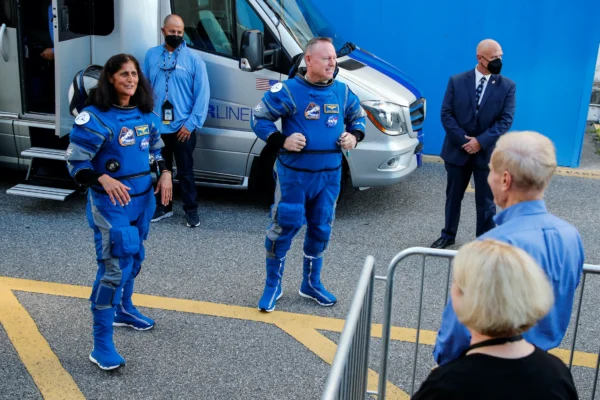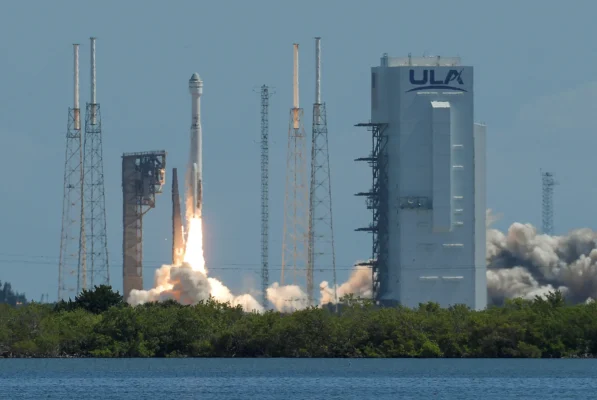Boeing’s third attempt to launch two astronauts into space was successful Wednesday at 10:52 a.m. ET., marking the company’s final test to become a space shuttle for NASA.
The gumdrop-shaped CST-100 Starliner capsule was at a launch pad at the Cape Canaveral Space Force Station in Florida, strapped to an Atlas V rocket from Boeing-Lockheed Martin joint venture United Launch Alliance (ULA).
A May 6 countdown was halted two hours before liftoff over three issues that required weeks of extra scrutiny. Another try last Saturday was halted less than four minutes before liftoff because of a glitch with a launchpad computer.
NASA said its teams worked overnight to assess the ground support equipment at the launch pad that encountered issues during the countdown and identified an issue with a ground power supply within one of the chassis. The supply provides power to a subset of computer cards controlling various system functions.
The chassis containing the faulty ground power unit was removed, visually inspected, and replaced with a spare chassis, the space agency said.
The crew for the seven-seat Starliner includes two veteran NASA astronauts: Barry “Butch” Wilmore, 61, a retired U.S. Navy captain and fighter pilot, and Sunita “Suni” Williams, 58, a former Navy helicopter test pilot with experience flying more than 30 different aircraft.
They are scheduled to stay for one week at the International Space Station.

Mr. Wilmore and Ms. Williams have spent a combined 500 days in space over the course of two ISS missions each. Mr. Wilmore is the designated commander for the flight, with Ms. Williams in the pilot seat.
If all goes as planned, the capsule will arrive at the space station on Thursday and dock with the orbiting research outpost some 250 miles above Earth.
Although Starliner is designed to fly autonomously, the crew can assume control of the spacecraft if necessary. The test flight calls for Mr. Wilmore and Ms. Williams to practice maneuvering the vehicle manually en route to the space station.

Two years ago, Boeing made its first trip to the orbital laboratory on an unmanned mission. Parachute and other issues were later discovered, delaying Starliner’s crew debut even further.
In 2019, Boeing attempted to launch an unmanned capsule to the space station for the first time, but the attempt was unsuccessful due to software problems.
Today’s launch was a final test for the company before NASA can certify it and hire it as a space shuttle for astronauts, a position Boeing was pressed to get after failures regarding its 737 MAX aircraft and rival SpaceX’s successful attempts at the space station.
Boeing’s Starliner venture is already several years behind schedule and more than $1.5 billion over budget.
Boeing was manufacturing modules for the ISS, as well as for rockets flying to the moon, and it was the first time it had built a whole spacecraft.
Meanwhile, SpaceX’s Crew Dragon has become a taxi to orbit for NASA. That capsule and Starliner are among the first in a new generation of privately built spacecraft—which NASA funded—designed to fly astronauts to low-Earth orbit and the moon under the U.S. space agency’s Artemis program.
Starliner would compete head-to-head with SpaceX’s Crew Dragon capsule, which since 2020 has been NASA’s only vehicle for sending crew members to orbit in the space station from U.S. soil.
Mr. Wilmore and Ms. Williams are due to join the International Space Station’s current seven resident crew members before riding the capsule back to Earth for a parachute and airbag-assisted landing in the U.S. Desert Southwest—a first for a crewed NASA mission.
Boeing made a $4.2 billion fixed-price contract with NASA, which likes the idea of having two transportation providers for its astronauts to the space station, which retires in 2030.
SpaceX’s Dragon Crew is scheduled for launch on Thursday. It will be a test for its reusable Starship satellite launcher and moon lander.
Reuters contributed to this report.

